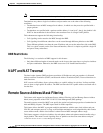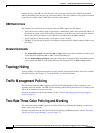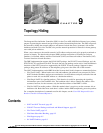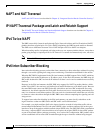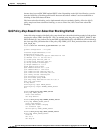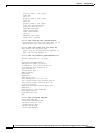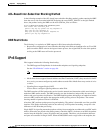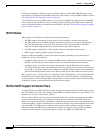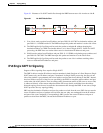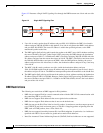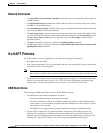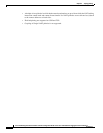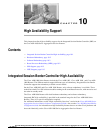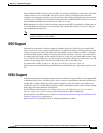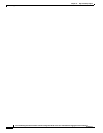
9-7
Cisco IOS XE Integrated Session Border Controller Configuration Guide for the Cisco ASR 1000 Series Aggregation Services Routers
OL-15421-01
Chapter 9 Topology Hiding
IPv6 Support
Figure 9-1 illustrates a No NAPT media flow through the DBE between user side A and user side B.
Figure 9-1 No NAPT Media Flow
1. User side A sends a packet from IP address and port 2001:10::10/17002 to destination address and
port 2001:11::11/28988 on side B. The DBE intercepts this packet and matches it to the side A flow.
2. The DBE applies QoS policing and forwards the packet to endpoint B without changing the
destination address to a DBE local media address (as is done in Single NAPT). Under No NAPT
processing, the DBE does not rewrite either source or destination IP addresses and ports.
3. Side B sends a packet from IP address and port 2001:11::11/28988 to originating source address and
port 2001:10::10/17002. The DBE intercepts this packet and matches it to the side B flow.
4. The DBE applies QoS policing and forwards the packet to user side A without rewriting either
source or destination IP addresses and ports.
IPv6 Single NAPT for Signaling
Support of IPv6 signaling flows requires Single NAPT.
The DBE is able to translate IP addresses and port numbers in both directions of a flow. However, Single
NAPT means only one IP address and port is translated. In Single NAPT processing, the flow on one
side of the pinhole is programmed with a local address and port that do not belong to the SBC. Instead,
that local address and port of the flow are specified by the MGC to match the remote address and port
on the other side of the pinhole. Thus, incoming traffic (downstream traffic of SIP server to access side)
is addressed directly to the remote endpoint and the SIP server details are hidden from subscribers.
Network topology must be used to route the downstream traffic through the DBE. In one sense, Single
NAPT provides one-way topology hiding.
SBC rewrites destination IP address and port for packets received from the user. SBC does not rewrite
source IP address and port of packets received from the user (they are unchanged from the IP address
and port of the source endpoint). Correspondingly, SBC rewrites the source IP address and port of
packets received from the MGC, but not the destination IP address or port.
1
4
2
3
User Side A User Side BDBE
recv
recv
send
send
230526
recv
recv
send
send
10.10.231.8:17002 10.10.231.8:1700282.19.12.134:28988 82.19.12.134:289882001:10::10/17002 2001:10::10/170022001:11::11/28988 2001:11::11/28988



